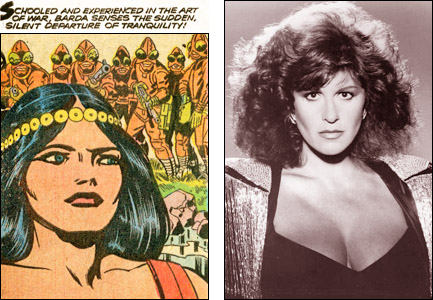
Among the questions I get about Jack Kirby are many having to do with a character he created for DC called Big Barda. I mentioned somewhere that she was inspired by an appearance in Playboy by singer Lainie Kazan and folks want to know more about that. Really, there isn't much more to it than that.
Jack had a subscription to Playboy. I have a vague idea — don't take this part as fact — that Harvey Kurtzman had arranged it. Kurtzman was of course producing "Little Annie Fanny" for Mr. Hefner's magazine back then and at one point, Jack declined an offer to help with the art on that strip. Kurtzman also at one point discussed with Jack (and it was never more than the briefest conversation) the notion of the two of them creating another strip for Playboy — one that could alternate with Ms. Annie and be in the Kirby style, albeit with nude women. Jack appreciated the interest in his services but did not think he'd be comfortable working for the magazine. His reasons were not just about the subject matter or the publication's image but also had to do with what he knew the working arrangements would be.
But he liked the magazine and had a pile of them in his studio. Some had pieces cut out of them because Jack enjoyed making collages of magazine photos, taking pieces and making them into something else when he arranged them on his board. Somewhere in at least one of those collages, he constructed a space ship of some kind out of clippings that once formed Miss August's breasts but were unrecognizable as such in the final product. Anyway, when the October, 1970 issue of Playboy arrived at the Kirby house, Jack smiled to see Lainie Kazan in it, sans wardrobe. He thought she was a beautiful lady and while Jack didn't necessarily prefer a large, formidable woman over any other, he did appreciate the beauty in that body type. It got him to thinking about concocting a super-heroine who looked like she could do the feats of strength that Wonder Woman or Supergirl did with more dainty physiques.
The creation of Barda began that day and was complete within days…but it would be wrong to suggest that Jack was drawing Lainie Kazan or that she suggested much more than a body type. A lot of non-writers don't get what it means when you say something in real life inspired a story. They think the writer is transcribing what really happened and just changing the names. That does happen but more often, a situation or an image or something becomes the starting point for fantasy. Carl Reiner once explained that he'd tell people that The Dick Van Dyke Show was based on his days working on Sid Caesar's variety shows…and they'd think Alan Brady was Sid and Carl's wife was Laura and that Carl therefore had a nightmare one night about Danny Thomas filling his closet with walnuts and so on. Nope. It's just a little something to build on and then you let your imagination kick in.
Like most artists, Jack based a lot of the people he drew on people he'd seen, both in person and on the screen. When he wrote dialogue for Darkseid — and to some extent when he drew the character's body language or expression — he had some qualities of Jack Palance in mind. Writers often "cast" a script that way just for their own benefit. Back when I was writing Bugs Bunny comic books, I had some interesting conversations with friends who were writing Superman or Spider-Man. Bugs had one well-established voice so when I wrote his dialogue, I could imagine Mel Blanc reading the words. Someone writing Aquaman had to make up a voice for their title character…and the next writer who handled the hero would have a different voice in mind.
In the case of Big Barda, the visual started with Lainie but all the personality and style was one of the many ways Jack viewed his spouse, Roz — especially the scenes where Barda would be fiercely protective of Scott "Mr. Miracle" Free. Jack, of course, saw himself as Mr. Miracle though the notion of a character who was a "Super Escape Artist" had started when writer-artist Jim Steranko told Jack about one of his previous careers. To some extent, Jack saw himself as all the decent characters he drew, and even the villains sometimes reflected aspects of himself of which he was not proud. But even that analogy only went so far and one must be cautious not to try and match reality up to everything Kirby did. Jack always started in reality and then moved way past it. He even moved past Lainie Kazan.